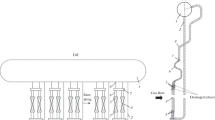Abstract
The structures of low-pressure heaters (LPH), which are installed at nuclear power plants with the K-1000-60/1500 type turbine plants are considered. It was revealed that only the PND-3 type low-pressure heaters have the damages of the heat exchange tubes. For a short operation life, the number of the damaged heat-exchange tubes of PND-3 is approximately 50 pcs for Kalinin NPP and 100–150 pcs for Balakovo NPP. The low-pressure heaters were manufactured at AO Ural Plant of Chemical Machine-Building “Uralkhimmash,” OAO Taganrog Boiler-Making Works “Krasny Kotelshchik,” and Vitkovice Machinery Group, but the damage nature of the heat-exchange tubes is identical for all PND-3. The damages occur in the place of passage of the heat exchange tubes through the first, the second, and the third partitions over the lower tube plate (the first path of the turbine condensate). Hydraulic shocks can be one of the possible causes of the damage of the heat-exchange tubes of PND-3. The analysis of the average thermal and dynamic loads of the tube systems of PND-1–PND-4 revealed that PND-3 by the thermal power are loaded 1.4–1.6 times and by the dynamic effects are loaded 1.8–2.0 times more than the remaining LPHs. Another possible cause of damage can be the cascaded drain of the separate into PND-4 and then through the drainage heat exchange into PND-3. An additional factor can be the structure of the condensate drainage unit. The advanced system of the heating steam flow and pumping scheme of the separate drain using the existing drainage pumps of PND-3 for K-1000-60/1500 turbine plants for Balakovo and Kalinin NPPs were proposed. The considered decisions make it possible to reduce the flow rate of the heating steam condensate from PND-3 into PND-4 and the speed of the heating steam in the tube space of PND-3 and eliminate the occurrence of hydraulic shocks and damages of the heat exchanger tubes.
Similar content being viewed by others
References
Branch Catalog. Heat-Transfer Equipment for Steam Turbine Units (Tyazhmash, Moscow, 1989), Part 1 [in Russian].
B. F. Vakulenko and M. P. Belousov, “On development of design and fabrication method of large-size low pressure surface heaters of TPP and NPP steam turbine units,” Teploenergetika, No. 11, 29–36 (1993).
Yu. P. Rassadkin, Water Ordinary and Extraordinary (Galereya STO, Moscow, 2008) [in Russian].
V. Ya. Karelin, Cavitation Phenomena in Centrifugal and Axial Pumps (Mashinostroenie, Moscow, 1975) [in Russian].
R. Knapp, J. Dailey, and F. Hammit, Cavitation (McGraw-Hill, New York, 1970; Mir, Moscow, 1974).
RTM 108.271.23-84. Calculation and Design of Surface Heaters of High and Low Pressure (Tsentr. Teplokotel’nyi Inst., Leningrad, 1985).
Author information
Authors and Affiliations
Corresponding author
Additional information
Original Russian Text © N.N. Trifonov, S.B. Esin, E.K. Nikolaenkova, Yu.G. Sukhorukov, F.A. Svyatkin, T.G. Sintsova, V.S. Modestov, 2017, published in Teploenergetika.
Rights and permissions
About this article
Cite this article
Trifonov, N.N., Esin, S.B., Nikolaenkova, E.K. et al. Probable causes of damage of heat-exchange tubes of low-pressure-exchanges of PND-3 type and repair methods. Therm. Eng. 64, 568–573 (2017). https://doi.org/10.1134/S0040601517080109
Received:
Accepted:
Published:
Issue Date:
DOI: https://doi.org/10.1134/S0040601517080109




